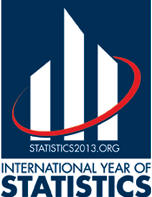|
|
|
Joseph
McKean, Western Michigan University, USA
Efficient Rank-Based Fits for Linear Models with Skewed-Normal Errors
The rank-based fit of a linear model is based on minimizing a norm. A score
function needs to be selected for the fit and the proper choice leads to
asymptotically efficient regression estimators, i.e., equivalent to the maximum
likelihood estimators (mle). In this talk, we present the family of optimal
scores functions for the skewed normal family. We show the easy computation of
this rank-based fit using the R package Rfit. We present the results of a small
simulation study comparing the rank-based estimators and the mles in terms of
efficiency and validity over skewed-normal and contaminated normal
distributions.
Ram Tripathi,
University of Texas, San Antonio, TX, USA
A new generalized negative binomial distribution based on
Stacy's gamma and an overview of other generalizations of
negative binomial distribution
Negative binomial distribution has been found suitable for
describing a wide variety of data in areas such as biology,
entomology, ecology, accident statistics and Social Sciences.
Various generalizations of this model are available in the
literature. In this paper, we present a generalized negative
binomial distribution (STGNBD) based on Stacy's generalized
Gamma (Stacey(1962)). Often in practice, one encounters data
which have more or fewer zeros than predicted by the negative
binomial or its generalizations. We also develop a
zero-modified version of the new STGNBD. The expressions for its
mean and variance are derived. The moment type estimators as
well as the maximum likelihood estimators for the parameters of
both the models are developed. Score test is developed for
testing if the STGNBD is an appropriate model rather than
zero-modified STGNBD. The models are fitted to some data sets
from the literature and compared with the fits afforded by other
similar models from the literature. Graphical comparisons are
made between the shapes of the STGNBD with the shapes of the
proposed zero-modified STGNBD for various parameter
combinations. A graphical comparison of relative error committed
when using the zero-modified STGNBD in place of the STGNBD
model is presented. An overview of other generalizations of
negative binomial distribution available in the literature is
presented along with a discussion of their areas of application.
Evdokia Xekalaki, Athens University of
Economics and Business, Greece
On the distribution theory of over-dispersion
An overview of the evolution of probability models for
over-dispersion will be given looking at their origins,
motivation, first main contributions, important milestones and
applications. Particular focus will be given on a specific class
of models called the Waring and generalised Waring models. We
will see what their advantages are relative to other classes of
models and how they can be adapted to handle multivariate data,
temporally evolving data and spatially evolving data.
Ramesh C. Gupta, University of Maine, USA
General frailty model in survival analysis
When making probabilistic models for survival times, one should
consider the fact that individuals are heterogeneous because
they differ in their susceptibility to causes of death, response
to treatment and influence of various risk factors. Some of this
heterogeneity can be taken care by modeling the failure rate by
the classical Cox proportional hazard rate (PHRM) model. The
observed covariate vector takes into account the heterogeneity
present. The unexplained heterogeneity is modeled by introducing
random effect in the hazard rate, called the frailty. In this
presentation, we propose a general frailty model and develop its
properties including some results for stochastic comparisons.
More specifically, our main results lie in seeing how the
well-known stochastic orderings between distributions of two
frailties translate into the orderings between the corresponding
survival functions. The results are used to obtain the
properties of the classical multiplicative frailty model and the
additive frailty model. Several of the results, in the
literature, are obtained as special cases. |
|
|



